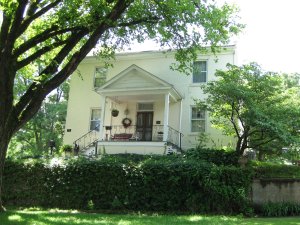McCausland House
Tour Stop
 Directions: The McCausland House [ Waypoint = N39 11.207 W93 53.143 ] is located at 908 Highland Avenue in Lexington Missouri 64067.
Directions: The McCausland House [ Waypoint = N39 11.207 W93 53.143 ] is located at 908 Highland Avenue in Lexington Missouri 64067.
Continue west on Main Street. Proceed for about one block and angle right onto Broadway Street. Proceed for another block and turn right (north) onto Highland Avenue. You should see the Madonna of the Trail statue on the northwest corner of the intersection. The McCausland House should be the first house on the left (west) side of the street. Stop and find a place to park.
Description: Susan Arnold McCausland remained in town throughout the siege and the battle. She wrote about what she saw in an article titled, "The Battle of Lexington as Seen by a Woman" that appeared in a 1912 issue of the Missouri Historical Review.
She begins by describing the mood in Lexington at the beginning of 1861:
"In the little town of Lexington on the river there was, in the early months of 1861, an eager impulse towards matters military, without however, any pronounced feeling of taking the side of either the North or South in the then undetermined policies of the two sections."
According to Mrs. McCausland, this all changed in May:
"...when occurred the tragedy of Camp Jackson, in St. Louis, when some raw recruits under Gen. Lyon fired upon a crowd of citizens without known provocation, killing a young woman, a boy, and wounding some others. This act set the State in a flame of feeling, with the result that an immediate alignment was made for one side or the other about to enter upon the great modern tragedy of the war between the States."
She described the siege in the following way:
"While Gen. Price waited at the fair grounds for the coming up of his ammunition wagons Col. Mulligan continued to strengthen his defenses. During these days of waiting continual skirmishing went on between the soldiers in town and small squads of those outside. The Southerners, becoming impatient of delay, daily cam dashing into town in small groups to give an exchange of shots and out again."
Susan McCausland described what she saw mid-morning on September 18th looking down Main Street:
"What I saw there was an army without any pretense of uniform of any kind, but moving with orderly precision into some determined-upon position. This was Gen. Parson's line, drawn along Main street. Gen. Rains' division took position on the east of the college, with Bledsoe's battery. Gen. Slack's column was extended along the west side, joining that of Gen. Parson on the south. I think that Guibor's Battery was moved about from place to place from time to time, as it was stationed near the intersection of Third and Tenth streets this first day, but went to Gen. Parson's division the next day, then back again west afterwards. On the morning of the second day of the investment, Gen. Harris and Gen. McBride completed the cordon by placing their lines on the north, along the river front. This line was supported throughout by Kelley's and Kneisley's batteries."
Susan McCausland wrote about the fighting for the Anderson House:
"At this time, I was standing at my post of observation from where I could see the Anderson House, the long line of earthworks behind it, and the besieging column on the west. I had been there but a very short time when I saw a double line of union soldiers rush over the top of the embankment, followed by the serried ranks of others, all firing upon the house as they hurtled down upon it, charging right through Mrs. Anderson's great, old-fashioned flower-garden trampling the still blooming poppies and tiger lilies. and how the men fell as they charged. The forms of the fallen lay motionless and the poppies nodded their blood-spattered heads about the now silent soldiers."
